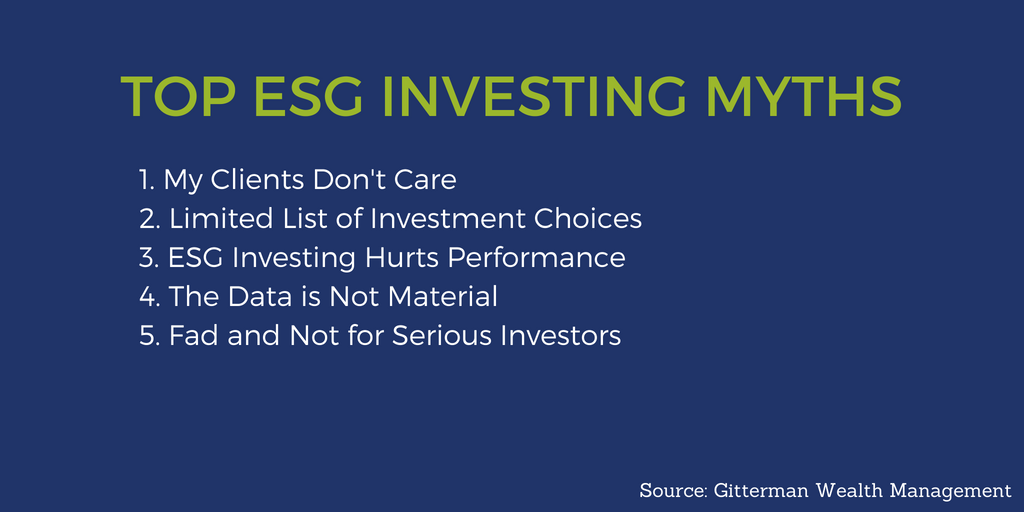Impact/ESG investing myths have been widely dispelled through much academic and practical research over the years, yet they still persist. Responsible investing is rapidly growing, having enjoyed a 135% increase in assets under management since 2012 to $8.72 trillion, yet the skeptics still remain.1 We recently co-hosted a webinar with Jeff Gitterman, co-founder of Gitterman Wealth Management, who dispelled 5 myths he commonly hears from RIAs and wealth managers:

Myth 1: My Clients Don’t Care
Key findings from a recent report, “Sustainable Signals” by Morgan Stanley’s Institute for Sustainable Investing uncovered that interest in sustainable investing remains high with 75% of individual investors and 86% of Millennial investors either “somewhat” or “very” interested in the concept.2 A report from Allianz Global Investors further confirms evidence that ESG investing continues to grow, with 83% of women, 80% of boomers, and 87% of millennials responding that they want values-based investing. The conundrum that follows is why are only 6% of advisors interested in ESG products for their clients despite the clear demand? Advisors saying “my clients don’t care” is clearly a myth. Instead, advisors should be looking at ESG/impact investing as one of the greatest business opportunities.
Myth 2: Limited List of Investment Choices
In 1995, there were 55 funds incorporating ESG factors representing $12 billion in assets. In 2016, there were 1,002 funds incorporating ESG factors representing over $2.5 trillion in assets.3 Lipper, which defines the category as socially responsible investments, counts 535 SRI mutual funds.4 In 2016, Morningstar launched their Sustainability Rating™ which covers more than 35,000 mutual funds and ETFs. Clearly, the list of investment choices in ESG/impact investing is vast and growing each year.
Myth 3: ESG investing Hurts Performance
The third myth around ESG is underperformance. Gitterman Wealth Management, our co-hosts on our recent webinar, produced a report in March showing that 74% of sustainable ESG funds outperformed their indexes during the worst weekly drop of the stock market in February. The report also highlights that four of the equity funds and three of the debt funds that they work with all outperformed their respective indexes over a five-year period. Morningstar reported that in the first nine days of February, a period over which the S&P fell 7.2%, two-thirds of all sustainable funds available in the U.S. finished in the top half of their respective categories. For equity funds, “65% outperformed their peers, with more than twice as many finishing in their category’s top quartile than in the bottom quartile”.5 Looking at longer time horizons, BofA Merrill Lynch Global Research released an update in June 2017 to a December 2016 study that showed stocks that ranked within the top third by ESG scores outperformed stocks in the bottom third by 18 percentage points in the 2005 to 2015 period.6
Myth 4: The Data is Not Material
In 1975, 83% of the S&P 500’s market value was based on tangible assets on the balance sheet. So, price of goods, cost of inventory, receivables, building inventory were all major factors of stock prices in the S&P 500. By 2015, 84% of the S&P 500’s market value was based on intangible assets or non-financial disclosure items.7 FANG stocks are a perfect example (FANG stocks include Facebook, Amazon, Netflix, and Google parent Alphabet and represent the most popular and best performing tech stocks in the market that have generated spectacular returns for their investors). None of the FANG stocks can be translated by stock price into hard data about those companies that is based on reputation, customer, brand, identity, customer loyalty, and employee retention. Another example is Tesla. Tesla represents less than 1% of the cars on the road today and they’re selling at a larger market cap then GM and Ford. The difference is the factors around ESG. ESG includes non-financial disclosure items that can provide us a better sense about a company’s stock price now and in the future.
Myth 5: Fad and Not for Serious Investors
In 1995, there was less than $1 trillion invested in ESG incorporated strategies, shareholder resolutions, and programs. Today, there’s just over $9 trillion in these same types of investments.8 Professor Robert Eccles of the Said Business School at the University of Oxford, conducted a survey of 582 institutional investors in partnership with State Street’s Center for Applied Research and found that the most common reason why institutional investors were integrating ESG factors were because they believed it helps “foster a long-term investment mindset” and “cultivate better investment practices”. Callan Associates’ fifth annual ESG survey released in 2017 found that by plan type, foundations and endowments continue to be the highest adopters of ESG investing at 56% and 39%, respectively, followed by public funds at 35%.9 Fads are short-lived; ESG investing looks like it’s here to stay.
Visit association websites like U.S. SIF for current educational resources on impact/ESG investing.
1Report on US Sustainable, Responsible and Impact Investing Trends 2016
3Report on US Sustainable, Responsible and Impact Investing Trends 2016
4https://www.barrons.com/articles/esg-charges-into-the-mainstream-1518462617
6https://www.unpri.org/download?ac=4218
7http://www.oceantomo.com/2015/03/04/2015-intangible-asset-market-value-study/
8Report on US Sustainable, Responsible and Impact Investing Trends 2016
